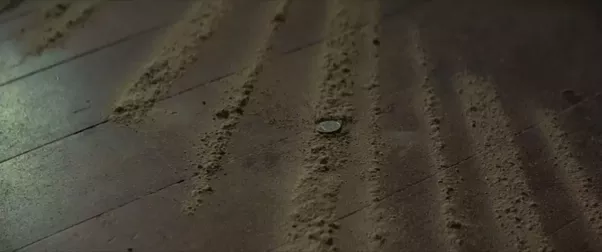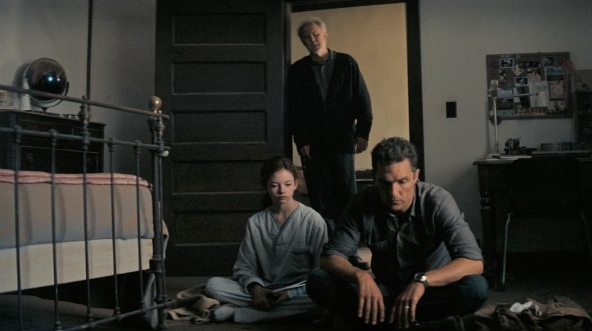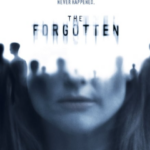Interstellar (2014)
Love is at the center of Interstellar, a 2014 dystopia/science fiction epic from Christopher Nolan and his brother Jonathan. Well, love plus gravity, as we’ll see below.
But first, we should note that watching Interstellar, you can’t help but see similarities to Stanley Kubrick’s 1966 milestone, 2001: A Space Odyssey. Christopher Nolan acknowledges that legacy, saying no space film can ignore 2001. Both works showcase technical brilliance and scientific accuracy in their depictions of spacecraft and of space itself. Both feature highly intelligent computers that are “crew members.” And both star heroic astronauts who buck desperate odds alone, far from home.
The Nolans’ epic, though, is 2001 with family values. Former astronaut Joe “Coop” Cooper (Matthew McConaughey) is a widower and the dad of teenage Tom (Timothée Chalamet) and 10-year-old Murphy (“Murph”) (Mackenzie Foy), a budding science prodigy. Like most people, Coop has become a corn farmer.

Why is an ex-astronaut growing corn? And why are “most people” doing that, too? Environmental disaster, that’s why. According to Coop’s father-in-law Don (John Lithgow), the problem was “6 billion people,” and they all “wanted it all.” Yup, sheer humanity was the problem, as well as folks wanting to better their lot in life. Somehow that has translated into the atmosphere starting to run out of oxygen, and the food supply dying out, with evidently no animals left and only a few crops, such as corn.
Not only that, but now a gigantic dust storm shows up and interrupts a local baseball game, forcing the townspeople in the stands to flee to their homes. (At least Americans still love baseball, environmental collapse or no.) Thick dust from an open window coats the floors in the Cooper home – and in one room something strange is going on: as if being written, vertical lines are appearing in the dust.

Murph is already used to oddities; recently books, a few at a time, have been getting bumped off her bookshelves, and she ascribes that to a “ghost” – a poltergeist, she surmises. Coop says gravity is the cause of the lines in the dust. With Murph watching, he copies them down. As Coop and Murph seek a pattern in the lines, father-in-law Don snidely remarks about the two “praying to them.”

Coop realizes the lines are a message in binary: “Thick is one, thin is zero.” He figures out that he’s seeing geographical coordinates. He decides he has to see the location. On the way, he discovers that Murph has stowed away in his truck. They arrive at a secret government facility and get arrested. A panel of NASA scientists asks how they found the place. Saying, “I hesitate to term it supernatural,” Coop explains that they learned the coordinates from “an anomaly.” Murph stuns the experts when she interjects that the anomaly’s cause was “gravity,” which they are researching.
On the panel, as it happens, are Dr. John Brand (Michael Caine), Coop’s former professor, and John’s daughter, Dr. Amelia Brand (Anne Hathaway). (It’s fun to see this revival of the 1950s sci-fi movie staple of the scientist and his pretty daughter-assistant.)
The senior Brand is given to explaining his motivation by ponderously quoting the poet Dylan Thomas: “Do not go gentle into that good night; Old age should burn and rave at close of day. Rage, rage against the dying of the light.”
Coop used to be the best pilot ever, so now they recruit him for a mission. Earth is dying, the human race will run out of food and suffocate, and we need a new home.
https://youtu.be/td-2X0Xx4Xw
Thanks to a wormhole that an unknown and evidently helpful “They” placed near Saturn 48 years ago, human travel through a space-time warp to find a hospitable planet in another galaxy has become doable. The senior Brand asks Coop to save the human race – to lead a mission to see if previous astronauts already sent out so far away that contact is nearly impossible might have found a suitable new home for humanity. The catch is that such travel will take up decades of Earth time, so Coop and his crew, including Amelia Brand, although not aging as they travel, might never see their families again.
The other catch is that the mission is only “Plan B” – taking along, as Amelia cheerily says, “over 5,000 fertilized eggs” [sic; once fertilization occurs, there’s no more egg, no more sperm, just a new human being]. These new humans have “genetic diversity” and are to populate a colony on another planet. At this point you might be asking, “Wait a minute, where are the ‘family values’ you said were in this movie?” They will show up – but, tragically, no character in the film counts the cost of all the babies’ lives lost in the creation, selection, and weeding out of these little humans.
The elder Brand says he’s working on a “Plan A,” which is to find the secret to overcoming gravitational pull so that many people can be sent into space later on.
Fatefully, Coop agrees to go, and Murph of course is heartbroken. She sees his leaving as a betrayal even though he promises to return. On their voyage, Coop and his crew – Amelia, two men, and two highly capable computers, TARS (voice of Bill Irwin) and CASE (voice of Josh Stewart) – undergo harrowing, albeit scenic, adventures.
Along the way, the topic of love enters in when Amelia, thinking of an almost certainly deceased astronaut she loved, confusedly tells Coop, “… love is not something we invented…It has to mean something…Maybe it’s…some artifact of a higher dimension that we can’t consciously perceive.” Her astronaut is never found.
Back home, Murph grows up and becomes a NASA scientist (Jessica Chastain) and remains bitter at her dad.
On his deathbed, Professor Brand confesses to Murph that he lied about his Plan A’s prospects – that he failed to “reconcile relativity to quantum mechanics” and his gravity project needs much more data. She takes on the project herself and beams out the bad news to space, where Coop and Amelia receive it. He realizes that the gravity data Murph needs can only be found by his going through a nearby black hole. Without telling Amelia, he and TARS, his computer, take off in a small vehicle, leaving her and CASE, her computer, on course for a promising planet. His sacrificial plunge into the black hole takes him on a 2001–type trip, but more plausibly depicted.
Now the family values kick in. SPOILER ALERT. Emerging from the black hole, Coop finds himself, along with TARS, in a tesseract structure, one side of which fronts 10-year-old Murph’s room. He sees her but can’t make himself heard, yet he is able to bump some books off her shelf – thanks to the time-space warp, he was the one bumping them years ago. Coop sees grownup Murph enter the room even as she now concludes her ghost/poltergeist was really her dad trying to help her. TARS has captured the precious data on gravity needed to solve Plan A, and Coop and the computer transmit it to adult Murph via the second hand of her childhood wristwatch. She is overjoyed to have the data that will save humanity, but even happier to know that her dad hadn’t abandoned her after all – that he had loved her deeply all the time.
Coop now believes that the unknown “They” are people from the future who have evolved to have superhuman capabilities. He sees that they chose Murph, not himself, to save humanity. The tesseract dissolves, and Coop floats off into space. He awakens in a space station and learns that Murph will be seeing him. She is now an aged and dying Murph (Ellen Burstyn). Their reunion is beautifully tender. She tells Coop she always knew he would come back. He asks how she knew, and she replies, in the movie’s best line, “Because my dad promised me.” Murph tells Coop to go to Amelia out in space. He takes off in a space ranger ship to do so, and the film ends with a shot of pensive Amelia, a galaxy away, as she looks over a little colony on humanity’s future home.
A flaw in Interstellar – as in 2001 and in virtually all films today – is that God is missing. To posit the unknown “They” as humans so far advanced they can move wormholes around in space is to try to substitute humanity for the reality that God exists and is the Creator. The film’s faith in ultra-evolution is unscientific, too; and, frankly, so is the notion that people could make Earth uninhabitable.
Interstellar’s MPAA rating is PG-13 for some intense perilous action and brief strong language. Christopher Nolan produced and directed. He and his brother Jonathan co-wrote the script. Hoyte van Hoytema was the cinematographer. Hans Zimmer composed the score. Paul Franklin was visual effects supervisor. Nathan Crowley was the production designer. Theoretical physicist and now-Nobel laureate Kip Thorne was a consultant and the executive producer.
— Dan Engler













